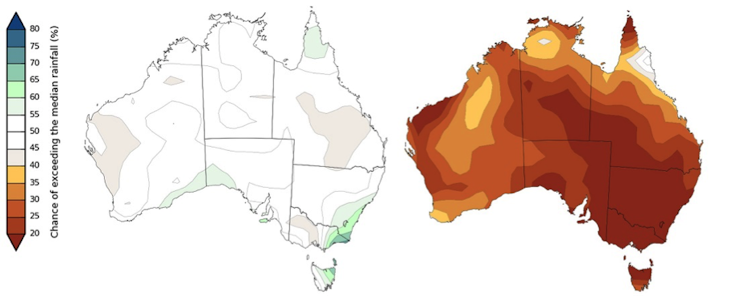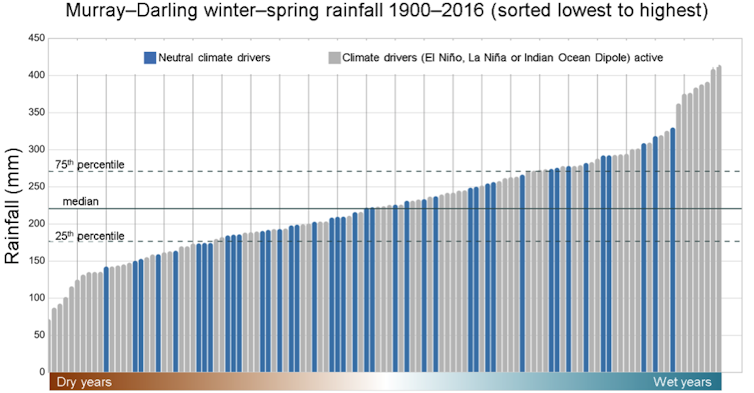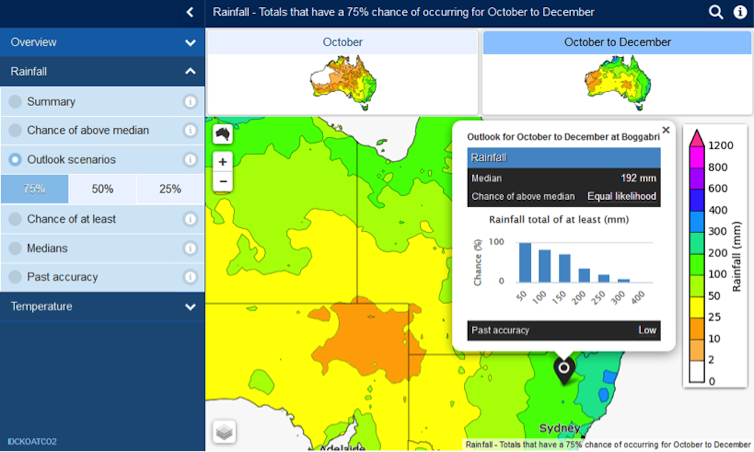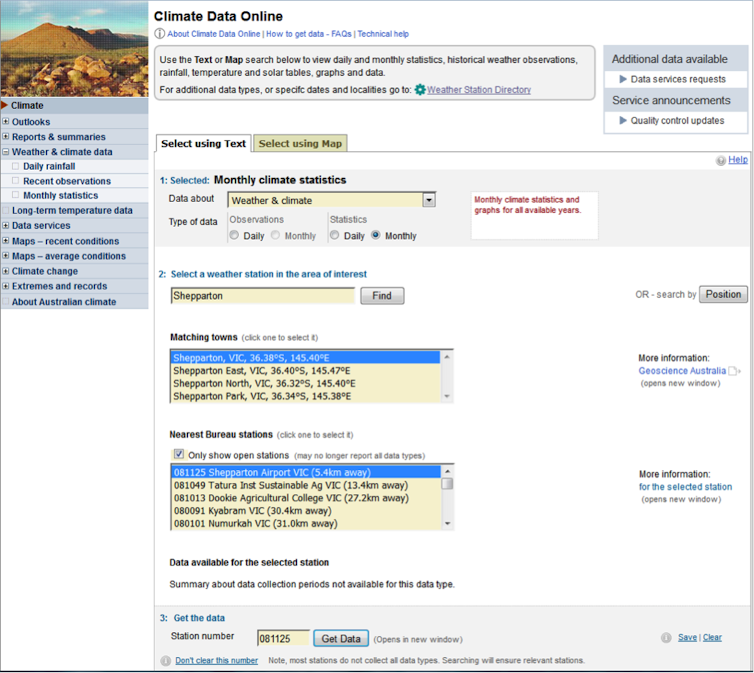
Photo by Loren Gu on Unsplash, CC BY-SA
Today the Bureau of Meteorology releases its end-of-month seasonal outlook for April to June, updating the initial outlook released on March 15. But you might not have seen much media coverage of it, because we’re not seeing big swings towards the attention-grabbing climate drivers like El Niño or the Indian Ocean Dipole, which can dominate Australia’s climate.
Read more: Dipole: the ‘Indian Niño’ that has brought devastating drought to East Africa
There are times when the main drivers of our climate are not strong enough to push us towards a season dominated by unusually wet or dry, or hot or cool, weather. This can also happen if different climate drivers are having opposite impacts – they can cancel each other out.
Without a strong push one way or another, our outlook maps are often white. This is a neutral or “50:50” outlook map.

Bureau of Metereology
A 50:50 outlook map doesn’t mean we’re taking a guess, or that there’s no indication of what’s happening with our weather and climate. In fact, it’s giving us some key information.
What does a neutral outlook mean?
Let’s focus on rain. A neutral climate outlook means there is a 50% chance of above-average rainfall. In other words, there is an equal chance of getting above-average or below-average rain over the coming season.
But it doesn’t mean that the most likely rainfall is spot-on average. Have a look at the graph below for rainfall in the Murray—Darling Basin. It shows rainfall over 116 years, ordered from lowest to highest. Years with no strong climate driver, or no strong push from the climate system one way or another, are in blue.

Most winter–spring periods (29 out of the 40 years, or about three-quarters of all years) fall within the middle 50% of past rainfall totals, as indicated by the 25th and 75th percentile lines. But within that middle 50%, the rainfall in neutral years is fairly evenly spread — it isn’t clustered right in the middle, or dead on average.
This means two things.
First, it means that a neutral year will typically bring quite variable rainfall, with periods of rainfall above or below average. We also know that the above or below patterns tend not to be as widespread across the continent as during stronger La Niña or El Niño periods.
Second – and importantly – it also means there is less chance of extremely wet or extremely dry conditions over large areas; that’s a good sign if drought or flood is a concern.
What doesn’t a neutral outlook mean?
A neutral outlook certainly doesn’t mean climatologists are having a bet each way. We can think about this in terms of a football game.
Some footy games we are fairly sure will be a one-sided affair — based on previous match performance, players’ injuries, whether it’s a home or away game, and so on. On other occasions, those factors aren’t in play and the teams are very evenly matched, so the result could go either way. It doesn’t mean we don’t know much about footy or about the teams that are about to play – it’s just that there is no strong indication that one team is far better than the other.
What can I do with a neutral outlook?
So what should you look at during neutral periods to get an idea of what’s possible for the upcoming season? Well, there’s lots of additional information on our climate outlooks website.
For a start, think about your local rainfall at a particular time of year, and what range you typically have in years without flood or drought. Use our rainfall ranges information to see your current rainfall accumulation, and what result you’ll get in a few months’ time if a typical range (wet, dry or average) of rain falls over the season.
The seasonal outlook itself may also be useful. For example, if you need a certain amount of rainfall, say 100mm over the next season, you can check out the likelihood of that happening. Or looking at it the other way round, what rainfall amount has a 25% (less likely) or 75% (more likely) chance of occurring, as shown below.

Other tools worth worth looking at in neutral periods include streamflow forecasts, which can tell you if streamflows are likely to be high, low or average in your region, and soil moisture guidance, to assess your soil moisture for daily and monthly periods.
And, of course, you can find the typical rainfall range for your area in our Climate Data Online. Select “Weather and Climate” at the top and “Monthly” statistics.

All of us – including climatologists – wish the outlooks were always clearly wet or dry, or hot or cool. It would certainly make all our lives a lot easier! But when the climate drivers are not strong, or oppose each other, there’s rarely any chance of a big push towards one outcome – and that information is still useful for making decisions.
A neutral outlook indicates a 50% chance of above-average rainfall. This means there is more chance of good rain than in a season with only 25% probability, but less chance than a season with 75%.
If your appetite for risk is high – if you are a farmer with good soil moisture, full dams and lots of money in the bank – 50% may be enough for you to take a punt on a riskier crop. But if times are tough, 50% may not be anywhere near high enough, so you’d make a more conservative decision. No number is ever too small if the return is high enough: most of us have bought a lottery ticket even though the odds might be one in a million.
At the end of the day, a 50% chance is a number just like any other. When combined with your knowledge of what a typical range of outcomes may be, other bureau information at your fingertips, and your appetite for risk, it can still help you make a climate-smart decision.
You can stay on top of what’s happening with the climate by subscribing to the Bureau of Meteorology’s Climate Outlooks.
![]() This is an edited version of a post that appeared on the Bureau of Meteorology’s blog.
This is an edited version of a post that appeared on the Bureau of Meteorology’s blog.
Andrew B. Watkins, Manager of Long-range Forecast Services, Australian Bureau of Meteorology and Felicity Gamble, Senior climatologist, Australian Bureau of Meteorology, Australian Bureau of Meteorology
This article was originally published on The Conversation. Read the original article.

HAVE YOUR SAY